Achilles Tendinitis
What is Achilles tendinitis?
Achilles tendinitis the inflammatory condition associated with pain at the Achilles tendon. This tendon is present at lower extremities, which extended from calf muscle to heel bone. This tendon connects the associated structures and holding the stress of the leg during walking, running or jumping this tendon.

Image 1: Anatomical view of Achilles Tendon
Achilles tendinitis occurs, when sudden and continuous stress builds up at the tendon. Achilles tendon cannot withstand this increased stress and tendinitis occurs. Athletes commonly affected with Achilles tendinitis.
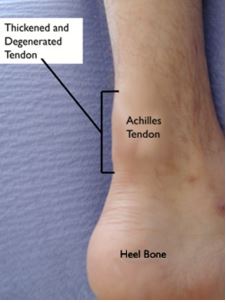
Image 2: Achilles tendinitis
Causes
- Sudden excessive stress builds up at the Achilles tendon is the common reason for Achilles tendinitis. The Achilles tendon can withstand with excessive stress, but before taking the stress, the physiology of the tendon should prepare for excessive stress. Sudden onset of stress mostly causes Achilles tendinitis. This will happen mostly with athletes who are not warming up properly or improper warming techniques also cause this problem.
- Not only athletes, most of the individuals experienced this problem due to continuous physical activity or extensive leg movement cause increase strain in the calf muscle.
- Irregular physical activities and sudden tennis playing and even unexpected discontinuation also increase the strain and tendinitis occurs.
- Wrong foot wears including hard sole shoe, high heel and undersized shoe cause tendinitis.
- The symptoms of arthritis and infectious disease also cause Achilles tendinitis.
- Difference in leg, foot or ankle size or anatomical abnormality of the lower limbs causes Achilles tendinitis. The individuals who have twisted foot, for them simple walking also increases the strain at the tendon, and they often complain about Achilles tendinitis.
- Using of a Fluroquinoles group of antibiotics such as ciprofloxacin, levofloxacin, norfloxacin, ofloxacin etc., increase the risk of tendon rupture and tendinitis. Pharmacovigilance study provides the information that after discontinuation of the antibiotic therapy; usually the adverse events are reported after several months. This side effect does not occur parallel with the therapy. Recently, FDA recommended that the label or package insert of these antibiotics should have the warning box.
Symptoms
The symptoms of the Achilles tendinitis are as follows:
- Pain in the ankle joint which will become worse in case untreated condition.
- Injury type of feeling arises at the junction of the heel bone.
- Stiffness in the lower part of the leg, especially in the morning
- Difficulty in walking
- Weakness and fatigue in the muscle of the lower limb
- Cuff muscle become paining which will worsen after speedy walking and running
- Pain is arisen at the Achilles tendon, after a couple of hours of after speed walking and running
- Stairs climbing, standing for a long time and fast running increase the pain scale
- At the site of the Achilles tendon inflammation is common.
- Harden the Achilles tendon
- Bone spurs
The symptoms are quite similar with other orthopaedic problems, it is advisable do not judge yourself, consult with a doctor help to reduce the symptoms and associated discomfort.
Diagnosis
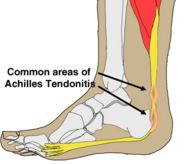
Image 3: Affected area in achilles tendinitis
The following tests are conducted to diagnose the Achilles tendinitis.
- X-ray: The X-ray provides the image of the tendon, tenderness or hardness at the Achilles tendon provides the indication of the Achilles tendinitis.
- MRI: Usually MRI is not frequently conducted. It is necessary to conduct before surgical intervention for estimating the severity of the condition.
- Ultrasound images also conducted to get the view of the tendon. It gives a clear image of inflammation.
Treatment
Usually following treatments are recommended by doctors to treat the Achilles tendinitis:
- Application of ice pack for reduction of pain
- Raising up the foot against pillow which helps to lessen the inflammation
- Doctors often prescribed non-steroidal anti-inflammatory medications to provide relief from pain and these also reduce the inflammation
- Compressed bandage and other orthotic devices provide the support to the heel which helps in reduction of pain and swelling.
- Doctors may also prescribe steroidal drugs, in case of severe pain which is not altered with other measures.
- In case of permanent damage at the Achilles tendon, surgery is the only option to provide relief from the symptoms.
Exercises
Physical exercise helps to lessen the pain and the inflammation in the tendon. The following instructions are important to follow:
- Avoid continuous high impact exercise at a stress. Adaptation of high-impact exercises like running, followed by and low-impact exercise like swimming helps to prevent increment of strain on the Achilles tendon.
- Stretching exercise is always advisable to conduct before high-impact exercises. Stretching exercise helps to improve the flexibility of the Achilles tendon and decrease the chance of development of the tendinitis.
- Calf stretching: Stand straight in front of a wall; palm should keep on the wall. One leg step forward from other leg and bent the knee. Other leg should be kept flat and the heel should be on the floor. Now give the pressure against the wall and feel the stretch at the calf. Hold the position for 15 seconds and then relax. Alter the leg and do the same process. Repeat the steps for 5 times.
Pictures

Picture 4 – Anatomy of Lower Leg Muscles
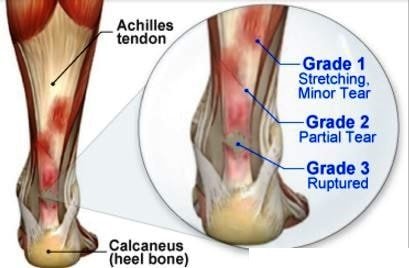
Picture 5 – Grading of Muscle Involvement in Achilles Tendinitis

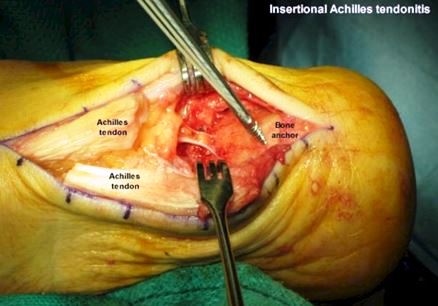
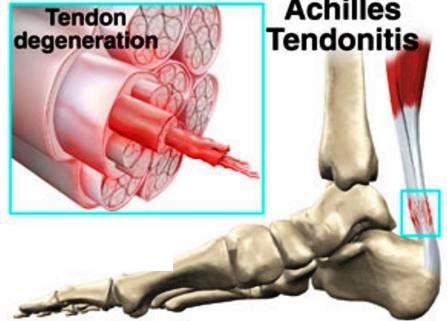
Image 8 – Tendon Degeneration in Achilles Tendinitis
References
- http://orthoinfo.aaos.org/topic.cfm?topic=a00147
- http://www.mayoclinic.org/diseases-conditions/achilles-tendinitis/basics/definition/con-20024518
- https://www.nlm.nih.gov/medlineplus/ency/article/001072.htm
- Achilles Tendon Injury (tear, rupture) Reviewed by Melinda Ratini, DO, MS on November 24, 2014 at http://www.webmd.com/fitness-exercise/guide/achilles-tendon-injury
- http://www.medicalnewstoday.com/articles/240819.php
- Achilles Tendinits Symptoms, causes & Diagnosis at http://www.healthline.com/health/achilles-tendinitis#Overview1
